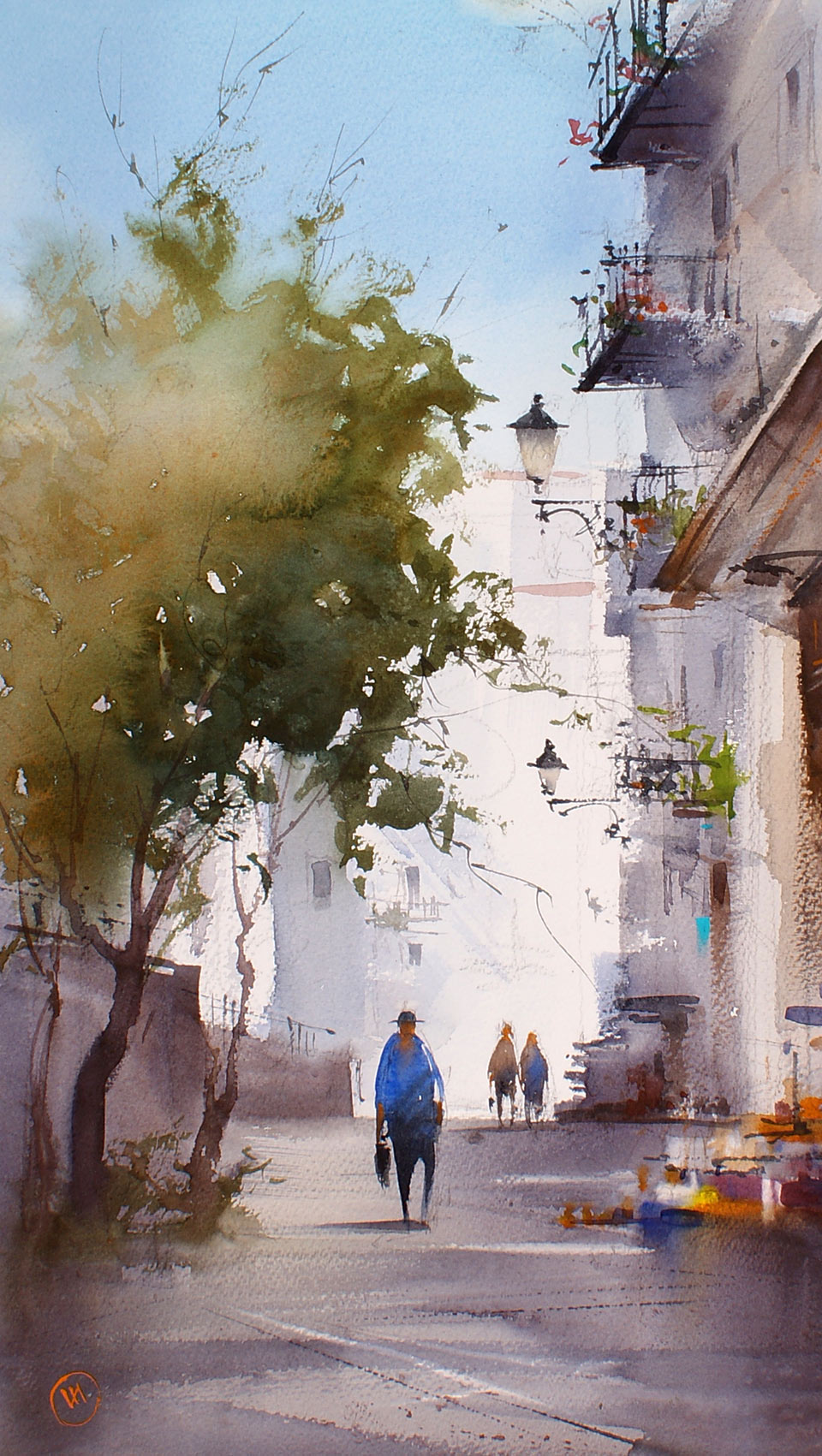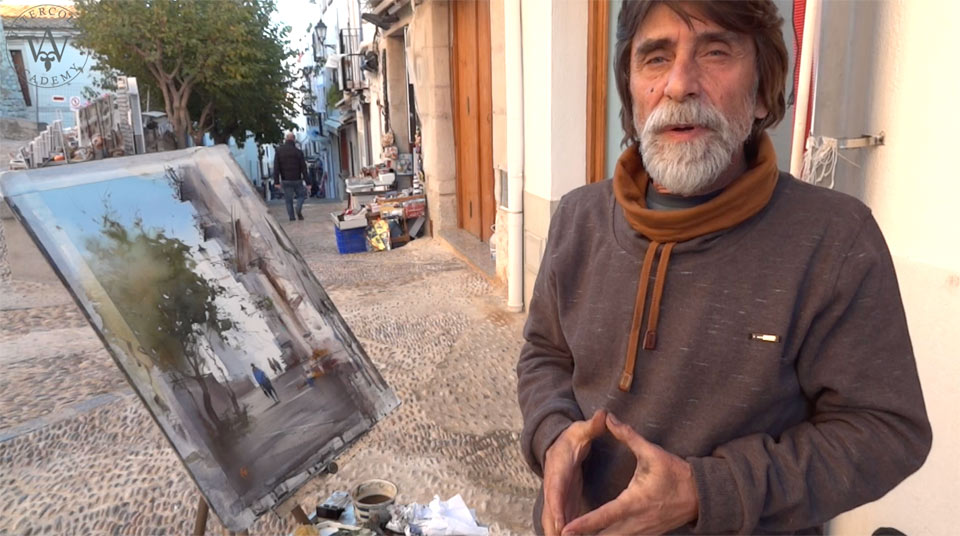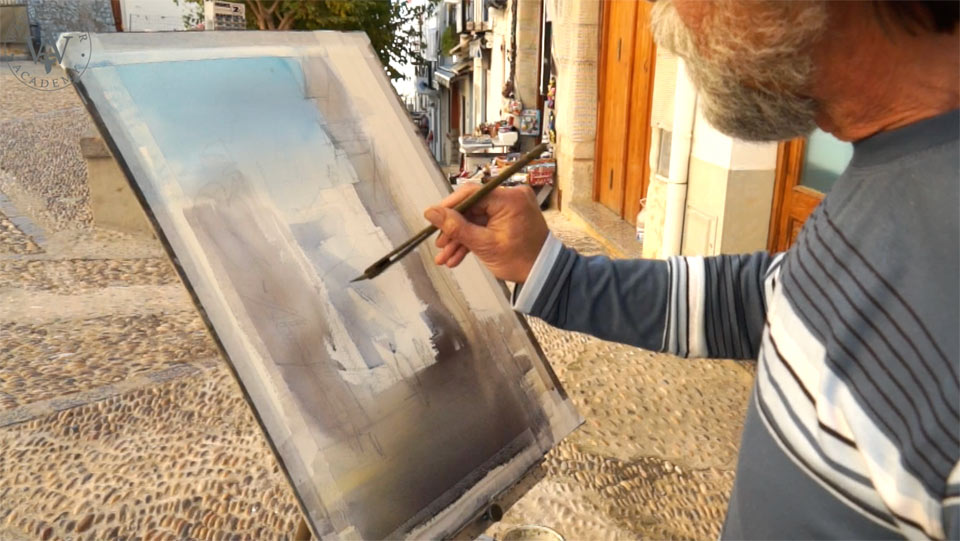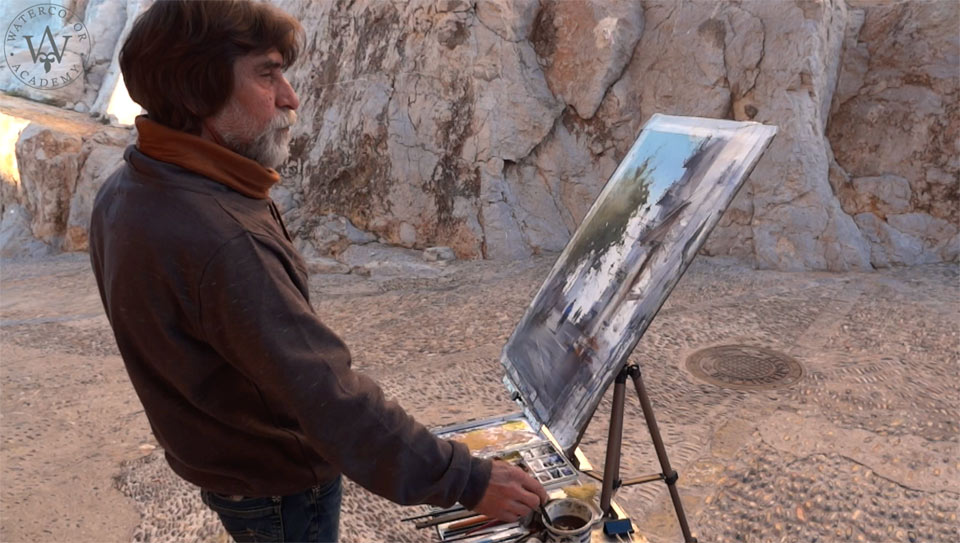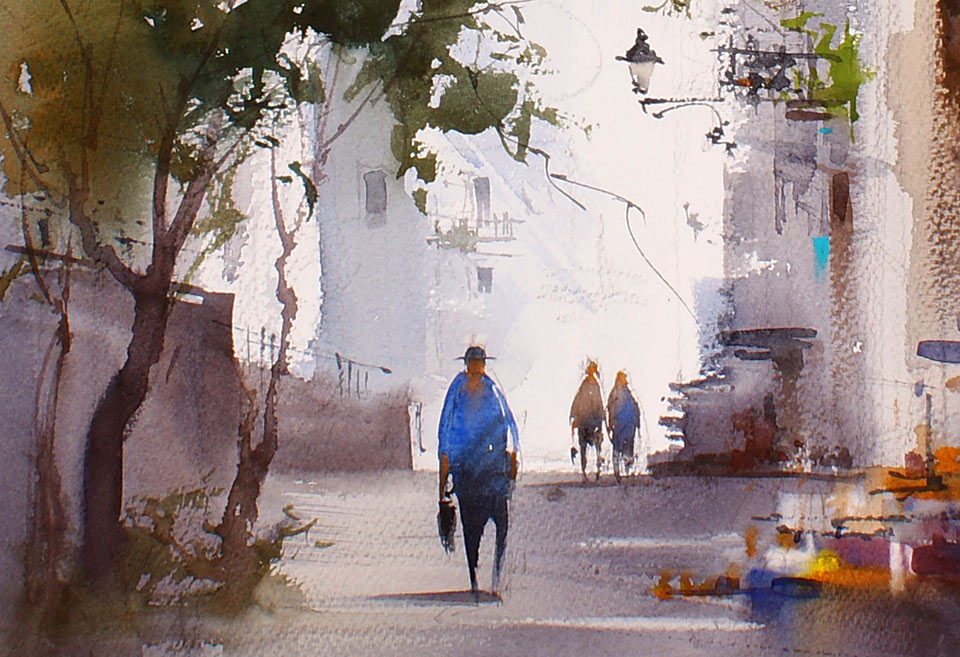How to paint a Street View in Watercolor
By Ilya Ibryaev
Here is an old street in a quiet Spanish town – I will be painting this in today's video lesson. The street is lit by beautiful light, and we have nice contrasts between light and shadow.
Here is the finished watercolor artwork that I will achieve by the end of this session.
This narrow street is in very old town that is located on the Mediterranean Sea. I start this artwork with a very rough sketch in graphite pencil. The creative task I have in mind is to depict this linear and aerial perspective.
I start with the blue sky, painting wet-on-dry with a wide brush. There is just enough water on the brush to apply a gradated wash without paint running down on the almost vertical board. After covering the whole sky in blue tint, I turn the board upside down and rotate it at different angles, to allow paint to flow in various directions. The gravity creates a very smooth gradation, from dark to light tonal values. I can also add more Ultramarine blue paint to make the top of the sky darker. The sky is done, and I can let it dry a bit, before continuing this watercolor. The board can be rotated from time to time, to make the gradation even softer. When the wet paper becomes satin, I continue, now painting the building using Ultramarine blue and Cadmium orange. Warm light is bouncing from the street to the wall, so to warm up the color, I add a little bit of Cadmium red. Blue and orange are complementary colors; it is very easy to go colder or warmer by adding more blue or orange into the mix.
I will paint three grounds in this artwork – the background, middle ground and foreground. To suggest an aerial perspective, the background will be cold and light. The middle ground is occupied by the buildings, and the colors are a bit warmer and darker. I will do this watercolor in alla prima, which means that it will be created in one session. You can see that I am painting with a large flat brush, For now, I do not pay much attention to small details – instead, I want to color the large areas fast. The foreground closest to us is a sunshine-lit pavement. It has to be warmer than the buildings, to visually bring it closer to the viewer. In such fast and laconic painting, colors and details are less important than tonal vales. I deepen up the values of the buildings and the pavement with confident wide brush strokes. This artwork will be quite impressionistic; it is more about impression over this street, rather than description. Before the paper dries, I can add more paint to increase the tonal values. Two main pigments that I am using are Ultramarine blue and Cadmium orange. Of course, there are other paints added to the mix, but nevertheless, it is better to maintain a limited number of colors. This helps to make the artwork stylized and to appear more united. It's time to return to the background. I add a few wide and loose brushstrokes to deepen it up. It is still lighter and colder than the middle ground. By this time, the middle ground has already dried. I can now paint shadows under the balconies in Cadmium orange and Ultramarine mix. Mixed together, they produce an almost neutral gray.
The casted shadows are made with swift diagonal brushstrokes. The architecture is depicted impressionistically, without many details. Just a few brushstrokes indicate the linear perspective. The ground is also touched up with swift brushstrokes. The direction of these strokes is horizontal, which separates the horizontal pavement from the vertical walls. I wipe off the paint using a semi-dry brush. It's now time to work on some details. For this purpose, I use a smaller flat synthetic brush, and I use more saturated colors. Because I paint in alla prima, the artwork develops quite fast. I add a few more brushstrokes here, before continuing to other areas of the artwork. The sky and backgrounds are dry by now. I can now paint the tree foliage wet-on-dry – for this purpose, I use Cadmium orange mixed with Sap green. I add more Cadmium orange into this mix, to make it warmer. Since this is a rather impressionistic artwork, I paint with very fast and loose brushstrokes. To depict the cold shadow, Ultramarine is added to the mix. To mute down the color, complementary Cadmium orange and Cadmium red are mixed with Ultramarine. As you can see, only four pigments are used for the tree crown. You may also notice that I leave some white spots unpainted, to suggest some gaps between the leaves. I spray the paper with water and rotate the board, so that the paint flows and intermixes. I will leave the tree to dry for now, and continue with the middle ground. There is a shadow under the tree, so I will deepen up this area, painting the shadow using a mix of Ultramarine and Cadmium orange – two complementary colors.
All of the main masses are in place, so I can now work on the small details. For this purpose, I use small round and flat brushes. The same mix of Ultramarine and Cadmium orange is in use here. To make this mix warmer, I could add more Cadmium orange and yellow ochre.
Painting outdoors, especially in public areas, can be challenging – after all, painting in watercolor requires concentration. I am very happy that this quiet town lives its usual life, without paying too much attention to what I am doing. Sometimes, you may be interrupted by spectators, who would like to talk to you, ask questions, or even give some advice. I am always open to such contacts, but when under pressure, because the paper dries quickly, it may be not enough time to do two things at once – both chatting and painting. The artwork is gradually taking shape; I am adding a few small bits and pieces here and there, working with a small round brush in dark color. Such details are added onto the dry paper; every brushstroke stays sharp and defined.
There is no need to paint everything I see. This is not a photograph, but an artistic impression of this place. To paint the tree trunk, I add to Ultramarine, both Cadmium orange and yellow ochre. Small size synthetic brushes are ideal for this job. The whole artwork is painted in just five pigments: Ultramarine, Cadmium orange, Cadmium red, yellow ochre and Sap green. Such a limited palette really helps me to keep the colors under control, and to concentrate more on tonal values. A street view always looks better when people are present. I will add three small figures to this artwork. Here is a couple painted as a silhouette, and a larger figure in blue clothes. The casted shadow anchors this figure to the ground...
[ The full lesson is avaibale to Watercolor Academy members ]
To learn how to paint a Street View in Watercolor, enroll now
Watercolor Academy Online Course
A self-study, self-paced course where you can learn how to paint in watercolor by watching video lessons and doing assignments
- Unlimited access to 80 watercolor painting video lessons
- Lifetime membership without deadlines
- Unlimited support from the Academy tutors
- Constructive critique of your artworks
- Member access to the Academy's Art community
- Place in the Academy's Students Gallery
- Exclusive members-only newsletter and bonuses
- Watercolor Academy Diploma of Excellence in your name
One-time payment - Lifetime membership
$297 USD
ENROLL NOW
Personal Tutoring online + Online Course
One-to-one, unlimited and custom-tailored to your skills and needs Personal Tutoring by the Watercolor Academy teachers
- Everything in Online Course, plus:
- Dedicated team of art tutors
- Assessment of your current level of art skills
- Personalized curriculum tailored to your skills and goals
- Up to 100 art tasks with by-task assessment
- Unlimited one-to-one personal coaching with detailed per-task instructions and feedback
- Artwork critiques and results-oriented guidance
One-time payment - Lifetime membership
$997 USD
ENROLL NOW
